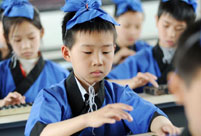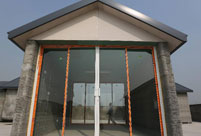 Ni Ni covers BAZAAR JEWELRY
Ni Ni covers BAZAAR JEWELRY
 Cherry blossoms reach peak bloom in Washington D.C.
Cherry blossoms reach peak bloom in Washington D.C.
 Top Chinese fashion icons in foreigners' eyes
Top Chinese fashion icons in foreigners' eyes
 Asia's largest business aviation exhibition to be held in Shanghai
Asia's largest business aviation exhibition to be held in Shanghai
 World's top-rated luxury hotels
World's top-rated luxury hotels
 Wu Jing, Xie Nan to hold wedding on May
Wu Jing, Xie Nan to hold wedding on May
 London Cake International attracts tourists
London Cake International attracts tourists
 Let's dance in harmonic Shaanxi
Let's dance in harmonic Shaanxi
 Christie's to auction dazzling diamonds
Christie's to auction dazzling diamonds
 'Model husband' shatters image of love
'Model husband' shatters image of love
CCTV: Judging from the 7.4 percent GDP growth in the first quarter this year, we see the national economy remains on a downward trend. Do you think the growth has slipped below the targeted range of figures that we set to maintain the normalcy of the economy? And would you please introduce the employment of the country, which I did not find in your introduction? Thirdly, what's your overall view on the national economy in the first quarter of this year?
Sheng Laiyun: Thanks for your questions. GDP grew by 7.4 percent in the first quarter of this year, a yearly decline of 0.3 percentage points. But it was still around 7.5 percent, which is set as the targeted growth. Besides, the 7.4 percent growth is comparatively high in light of the overall global economy.
To tell whether the growth slips below the target or the economy remains in its normalcy, we need to take employment and income, in addition to the figure of growth, into consideration. It is for the sake of employment that we maintain the growth of the economy, because employment is a guarantee of the livelihood of the people. Judging from the statistics for income and employment, we find the overall economy has performed comparatively well in the first quarter.
I will give you statistics in regards to your question on employment. Urban employment increased by 3 million in the first quarter of this year, which registered a growth year-on-year. The job market is generally stable as we have been told so far. A survey launched to monitor migrant workers showed that the first quarter saw a year-on-year increase of 2.88 million migrant workers who had been employed outside their hometowns for at least six consecutive months -- a yearly growth of 1.7 percent. During our survey, many enterprises were found to be difficult in hiring migrant workers. Based on the abovementioned figures and cases, we still found overall employment was stable and moderately good.
Thanks to the growing employment rate, resident incomes increased at the same time. The cash income of a rural resident on average actually grew by 10.1 percent, and the disposable income of an urban resident by 7.2 percent. Both increased faster year-on-year. Meanwhile, prices were comparatively stable as the Consumer Price Index (CPI) grew by 2.3 percent in the first quarter of this year -- a growth that proved both moderate and controllable. Based on the figures of employment, income and CPI, the overall economy remained in its normalcy despite the slowed growth.
In addition to the abovementioned points, there is one more aspect to be highlighted in the national economy: the structural adjustment, transforming and upgrading. First of all, the industrial structure has been continuously improved. The tertiary industry made up 49 percent of the GDP and the proportion rose by 1.1 percentage points yearly. The yearly growth of the tertiary industry was 0.5 percentage points faster than that of the secondary industry. And the secondary industry also happened to experience positive change. The growth of the added value of equipment manufacturing and high-tech industries was around 3 percentage points higher on average than that of the industrial enterprises above designated size (enterprises with annual sales exceeding 20 million yuan). All those combined demonstrated that the industrial structure underwent positive changes under the market mechanism.
The second positive change is that the relation between investment and consumption became more reasonable. The growth of investment in the first quarter slowed down; however, the growth in retail is comparatively stable. Resident consumption grew quicker too. Therefore, the contribution of consumption to the economic growth increased. At the same time, there are positive structural changes to be found within the investments such as the investments in the tertiary industry and the increase of the private investments, which reached to 64.8 percent, rising by 1.5 percentage points year-on-year.
The third positive structural change is the allocation of income. The nominal growth of resident income was nearly 2 percentage points higher than enterprise profits and the fiscal revenue, which means the resident income accounts for an increasing part of the GDP. Meanwhile, the income gap between urban and rural residents narrowed. If we simply do the math, the ratio between the incomes of rural and urban residents was 1:2.53, which means the gap was narrowed and the income distribution structure was in fact improved.
On a fourth note, we have made achievements in raising both the quality and efficiency of the economy so as to save energy and reduce consumption.
In light of the employment, income, prices and structural adjustment, the economy remains in normalcy in spite of a slowed GDP growth. There are no signs that the economy has fundamentally changed from the stable growth and improvement. It remains developing along the expectations of macro-control.


 Children in ancient costumes learn Zhusuan
Children in ancient costumes learn Zhusuan Tens of thousands celebrate Water Splashing Festival
Tens of thousands celebrate Water Splashing Festival A bite of China II whets the appetite
A bite of China II whets the appetite Chinese frigate completes its 14th escort mission
Chinese frigate completes its 14th escort mission Let's dance in wealthy Shaanxi
Let's dance in wealthy Shaanxi A date with 798: feel the art around you
A date with 798: feel the art around you 3D-printed houses built in Shanghai
3D-printed houses built in Shanghai World largest scale of umbrella dance
World largest scale of umbrella dance Cherry blossoms reach peak bloom in Washington D.C.
Cherry blossoms reach peak bloom in Washington D.C. The backstage of the Fashion Week
The backstage of the Fashion Week College students in Han costumes
College students in Han costumes Postgraduate works as waitress
Postgraduate works as waitress Life in a Lahu village in Yunnan
Life in a Lahu village in Yunnan An orphan’s wedding
An orphan’s wedding Hollywood documentary brings Diaoyu Islands truth to new audience
Hollywood documentary brings Diaoyu Islands truth to new audienceDay|Week|Month